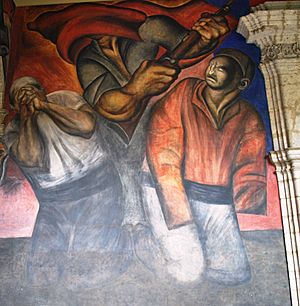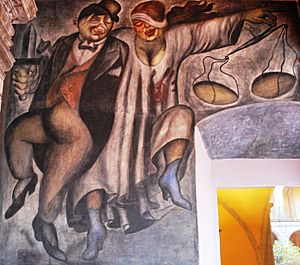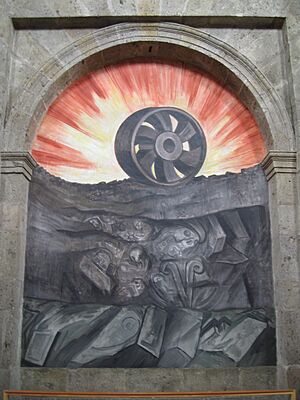José Clemente Orozco facts for kids
Quick facts for kids
José Clemente Orozco
|
|
|---|---|
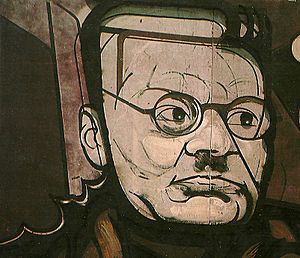
Portrait of Orozco by David Alfaro Siqueiros
|
|
| Born | November 23, 1883 Ciudad Guzmán, Mexico
|
| Died | September 7, 1949 (aged 65) Mexico City, Mexico
|
| Nationality | Mexican |
| Education | San Carlos Academy |
| Known for | Painting, Muralist |
| Movement | Mexican Mural Movement, Social Realism |
| Awards | National Prize for Arts and Sciences |
José Clemente Orozco (born November 23, 1883 – died September 7, 1949) was a famous Mexican artist. He was a caricaturist, which means he drew funny or exaggerated pictures of people. He was also a painter. Orozco was best known for his large political murals. These murals helped start the Mexican Mural Renaissance. Other famous artists like Diego Rivera and David Alfaro Siqueiros were also part of this movement.
Orozco's art often showed human suffering. He was interested in machines and less realistic than Rivera. He was also a genre painter (painting scenes from everyday life) and a lithographer (making prints). Between 1922 and 1948, Orozco painted murals in many cities. These included Mexico City, New York City, and Guadalajara. His drawings and paintings can be seen in museums today. Orozco used his art to support farmers and workers.
Contents
Life of José Clemente Orozco
José Clemente Orozco was born in 1883 in a town called Zapotlán el Grande. This town is now known as Ciudad Guzmán in Jalisco, Mexico. He was the oldest child in his family. In 1890, his family moved to Mexico City. This is where Orozco first became interested in art. He later married Margarita Valladares and had three children. When he was 21, Orozco had an accident while making fireworks. He lost his left hand.
A famous artist named José Guadalupe Posada greatly influenced Orozco. Posada made engravings about Mexican culture and politics. He worked in shop windows where Orozco walked to school. Orozco loved watching him work. He said it was the first thing that made him want to draw. Posada also taught him about using color.
Orozco first studied agriculture and architecture. Then, from 1906 to 1914, he studied art at the Academy of San Carlos. He joined a student strike in 1911 with David Alfaro Siqueiros. Orozco also worked as an illustrator for newspapers in Mexico City. He even drew for one of the armies during the Mexican Revolution.
The violence Orozco saw during the revolution deeply affected his art. He wrote that "The world was torn apart around us." He saw troops going to battle and trains being blown up.
In 1916, Orozco went to the United States. He was not happy with how his art was received in Mexico. Four years later, he returned to Mexico City. He started working as a cartoonist. In 1923, Orozco began his first mural project. His paintings showed his dark feelings about the war.
Orozco was a leader of the Mexican Muralism art movement, along with Diego Rivera. Orozco had a darker view of the Mexican Revolution than Rivera. Rivera was often hopeful about the revolution. But Orozco was troubled by the bloodshed. Orozco, Rivera, and David Alfaro Siqueiros are known as the 'Big Three' muralists. They all used a painting method called fresco on large walls. This helped make mural art very important.
Between 1922 and 1924, Orozco painted many murals at the National Preparatory School. Some of these were Maternity and The Trench. Some of his murals were damaged by students or even by Orozco himself. He had to repaint many of them later. In 1925, he painted the mural Omniscience in Mexico City. The next year, he painted a mural in Orizaba, Veracruz.
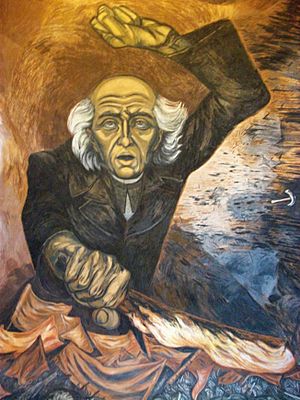
From 1927 to 1934, Orozco lived in the United States. Even during the Great Depression, his art was still wanted. In 1930, he painted a fresco called Prometheus at Pomona College. This was one of the first modern frescoes in the U.S.
Later that year, he painted murals at the New School for Social Research in New York City. One of his most famous murals is The Epic of American Civilization. This mural is at Dartmouth College in New Hampshire, USA. He painted it from 1932 to 1934. It covers a huge area and has 24 panels. These panels show different parts of American history and culture. His art was also part of the art competition at the 1932 Summer Olympics.
After returning to Mexico in 1934, Orozco painted The Catharsis. This mural is at the Palacio de Bellas Artes in Mexico City. He also painted in Guadalajara, Jalisco. His frescos for the Hospicio Cabañas are seen as his best work. In 1940, he painted at the Gabino Ortiz Library. From 1942 to 1944, Orozco painted for the Hospital de Jesús Nazareno in Mexico City. His large portrait-mural Juárez Reborn in 1948 was one of his last works.
In 1947, he drew pictures for the book The Pearl by John Steinbeck.
José Clemente Orozco died peacefully in his sleep on September 7, 1949. He passed away from heart failure.
Dartmouth College Mural
Orozco painted his fresco called The Epic of American Civilization at Dartmouth College. It is located in the lower level of the Baker Memorial Library. This mural tells a big story about American history.
Murals at Escuela Nacional Preparatoria
History and Overview
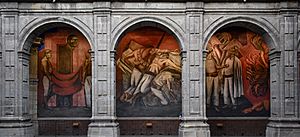
José Clemente Orozco painted a series of murals at the Escuela Nacional Preparatoria. This building is part of San Ildefonso College. His murals cover three floors and the stairway. They show his critical views of the Mexican Revolution. He started painting them in 1923. However, his early murals caused problems. He had to stop working, just like Siqueiros. He later came back in 1926 to finish his art.
First Floor Murals
On the first floor, you can see murals like The Trench, The Destruction of the Old Order, and Maternity. Other murals include The Strike, The Trinity, and The Banquet of the Rich. The Trench is a very powerful painting. It shows three men sacrificing themselves. Their faces are hidden, which makes them represent all the unknown people who died in the revolution. This mural uses dark colors to match its serious theme. It makes you think about the cost of war.
The Trinity shows a negative side of the revolution. A revolutionary leader is shown hurting the very people he is supposed to help. This mural suggests that the working class was confused about who they were fighting for.
The Banquet of the Rich is a social commentary. It uses Orozco's unique style of drawing exaggerated figures. The rich people are shown with distorted faces and bodies. This is meant to show their bad behavior and misuse of power. The working class is shown fighting each other for the entertainment of the rich. This mural makes viewers think about social inequality.
Second Floor Murals
The murals on the second floor were painted in 1923-1924. They include Law and Justice, Jehovah Between the Rich and the Poor, Liberty, Garbage, and The Rich.
Third Floor Murals
The third floor murals were created between 1924 and 1926. They feature Women, The Grave Digger, The Blessing, The Workers, The Farewell, The Family, and The Revolutionaries.
The Farewell is a large mural. It shows the moments before people go off to fight in the Revolution. The scene is sad. It shows couples and groups of men saying goodbye. This mural suggests that fighting in the revolution was a natural and unavoidable part of life.
Stairway Murals
Orozco also painted murals in the stairways from 1924 to 1926. These include Aboriginal Races, Franciscans Helping the Sick, The Youth, and Cortés and Malinche.
Cortés and Malinche shows the meeting of the Spanish conqueror Cortés and his Native American partner, Malinche. This union led to the first mestizos, people of mixed Spanish and Indigenous heritage in Mexico. Orozco shows Cortés as powerful and Malinche as less so. This mural represents the start of a new mixed culture in Mexico.
Gallery
Tribute
On November 23, 2017, Google celebrated Orozco's 134th birthday with a special Google Doodle.
Exhibitions
- "¡Orozco!" by The Ministry of Foreign Affairs and the Institute of Fine Arts, Mexico at The Museum of Modern Art, Oxford, 1980.
- "José Clemente Orozco in the United States, 1927-1934" at the Hood Museum of Art, Hanover NH, 2002.
- "Vida Americana: Mexican Muralists Remake American Art, 1925-1945" at the Whitney Museum of American Art, New York, 2020.
Selected Artworks
- Praying Hands, 1900-1924
- Man Struggling Against Nature, 1923–24
- Man Falling, 1923–24
- Christ Destroying His Cross, 1923–24
- Law and Justice, 1923–24
- Jehovah Between the Rich and the Poor, 1923–24
- At San Ildefonso College:
- Maternity, 1923–24
- The Banquet of the Rich, 1923–24
- The Strike, 1923–24
- The Elements, 1923–24
- Liberty, 1923–24
- Garbage, 1923–24
- The Rich, 1923–24
- Women, 1924-1926
- The Grave Digger, 1924-1926
- The Blessing, 1924-1926
- The Workers, 1924-1926
- The Farewell, 1924-1926
- The Family, 1924-1926
- The Revolutionaries, 1924-1926
- Aboriginal Races, 1924-1926
- Franciscans Helping the Sick, 1924-1926
- Cortés and Malinche, 1924-1926
- The Drinking Men, 1924-1926
- Engineers, 1924-1926
- The Trench, 1926
- The Destruction of the Old Order, 1926
- The Subway, 1928
- Échate la otra, 1930, Cleveland Museum of Art
- Wounded Soldier, 1930, Cleveland Museum of Art
- At Dartmouth College Library:
- American Civilization: Modern Human Sacrifice, 1932
- American Civilization: Ancient Human Sacrifice, 1932
- American Civilization: The Gods of The Modern World, 1932
See also
 In Spanish: José Clemente Orozco para niños
In Spanish: José Clemente Orozco para niños
- Mexican art
- Mexican Muralism





